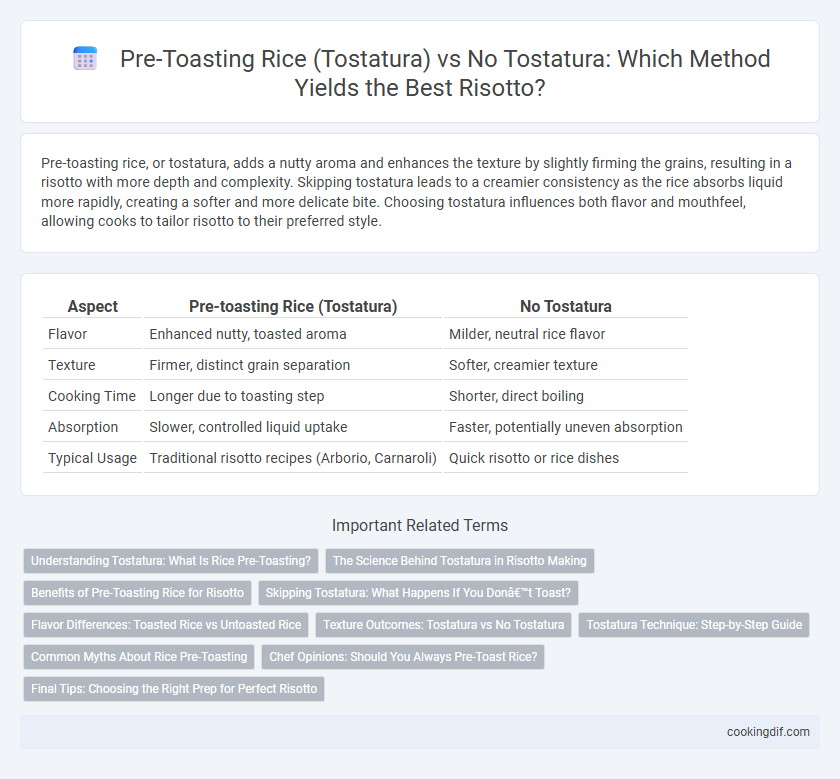Pre-toasting rice, or tostatura, adds a nutty aroma and enhances the texture by slightly firming the grains, resulting in a risotto with more depth and complexity. Skipping tostatura leads to a creamier consistency as the rice absorbs liquid more rapidly, creating a softer and more delicate bite. Choosing tostatura influences both flavor and mouthfeel, allowing cooks to tailor risotto to their preferred style.
Table of Comparison
| Aspect | Pre-toasting Rice (Tostatura) | No Tostatura |
|---|---|---|
| Flavor | Enhanced nutty, toasted aroma | Milder, neutral rice flavor |
| Texture | Firmer, distinct grain separation | Softer, creamier texture |
| Cooking Time | Longer due to toasting step | Shorter, direct boiling |
| Absorption | Slower, controlled liquid uptake | Faster, potentially uneven absorption |
| Typical Usage | Traditional risotto recipes (Arborio, Carnaroli) | Quick risotto or rice dishes |
Understanding Tostatura: What Is Rice Pre-Toasting?
Rice pre-toasting, known as tostatura, involves lightly toasting Arborio or Carnaroli rice grains in oil or butter before adding liquid, enhancing flavor and texture in risotto. This process helps seal the starch inside the grains, allowing for a creamier consistency while maintaining a slightly firm bite. Skipping tostatura results in a softer texture with less complex toasty notes, impacting the overall richness and mouthfeel of the risotto.
The Science Behind Tostatura in Risotto Making
Pre-toasting rice, known as tostatura, initiates the Maillard reaction that enhances the nutty flavor and aroma essential in risotto. This process slightly hardens the starch granules, creating a barrier that controls starch release during slow cooking, resulting in a creamier texture without becoming mushy. Without tostatura, rice absorbs liquid more rapidly, risking uneven cooking and a less complex flavor profile.
Benefits of Pre-Toasting Rice for Risotto
Pre-toasting rice in risotto preparation enhances the grain's texture by creating a slightly firmer exterior that holds shape during slow cooking. This process also intensifies the nutty flavor, adding depth and complexity to the final dish. Additionally, tostatura helps in better absorption of broth, resulting in a creamier, more balanced risotto.
Skipping Tostatura: What Happens If You Don’t Toast?
Skipping tostatura in risotto preparation results in rice grains absorbing liquid too quickly, causing a less controlled release of starch and a creamier, sometimes mushier texture. Without pre-toasting, the rice lacks the subtle nutty flavor and firmer bite that toasting imparts, which may compromise the dish's traditional al dente quality. Chefs often find that skipping this step leads to a less nuanced flavor profile and a potentially overcooked consistency.
Flavor Differences: Toasted Rice vs Untoasted Rice
Pre-toasting rice (tostatura) in risotto preparation enhances the grain's nutty aroma and intensifies its flavor complexity by slightly caramelizing the starches before cooking. Untoasted rice yields a milder, creamier texture with a more subtle, delicate taste that allows the broth and added ingredients to shine prominently. Tostatura creates a toasted, earthy depth that contrasts with the softer, more neutral profile of raw rice, influencing the overall sensory experience of the risotto.
Texture Outcomes: Tostatura vs No Tostatura
Pre-toasting rice (Tostatura) enhances the grain's texture by creating a firmer, more al dente bite with a nutty flavor profile, as the heat slightly dehydrates the rice surface and seals in starch. Without Tostatura, the rice tends to absorb liquid more rapidly, resulting in a creamier, softer texture typical of traditional risotto. The choice between Tostatura and no Tostatura directly impacts the risotto's mouthfeel, balancing between toothsome firmness and tender creaminess.
Tostatura Technique: Step-by-Step Guide
Pre-toasting rice, known as tostatura, involves gently heating the grains in oil or butter until they become translucent, enhancing their nutty flavor and ensuring better texture retention during cooking. To perform tostatura, first warm the fat in a pan over medium heat, then add the rice, stirring constantly until the edges of the grains appear slightly transparent but not browned. This technique seals the starch, promoting even absorption of broth and resulting in a creamier, more structured risotto compared to skipping pre-toasting.
Common Myths About Rice Pre-Toasting
Pre-toasting rice, or tostatura, is often believed to significantly enhance risotto's texture and nutty flavor, but scientific studies show the effect is minimal compared to other cooking factors like broth quality and stirring technique. Many chefs insist tostatura prevents rice from becoming mushy, yet amylopectin gelatinization during cooking plays a more critical role in achieving the ideal creamy consistency. Common misconceptions also claim tostatura reduces cooking time, but actual variations are negligible, making it an optional step rather than a crucial one in risotto preparation.
Chef Opinions: Should You Always Pre-Toast Rice?
Chefs are divided on pre-toasting rice (tostatura) in risotto preparation; many argue it enhances flavor by boosting nutty aromas and improving texture through slight starch coating. Others suggest skipping tostatura preserves the rice's delicate starch release essential for the creamy consistency characteristic of traditional risotto. The choice depends on desired texture and flavor profile, with top chefs tailoring the step according to dish style and rice variety such as Arborio or Carnaroli.
Final Tips: Choosing the Right Prep for Perfect Risotto
Pre-toasting rice (tostatura) enhances the nutty aroma and creates a slightly firmer texture by coating grains with hot fat, which slows water absorption and maintains individual grain integrity throughout cooking. Skipping tostatura results in a creamier risotto as starch releases more rapidly, ideal for a softer, more cohesive dish. Selecting the right prep depends on the desired risotto texture: use tostatura for al dente grains with pronounced flavor, or omit it for a silkier, more luscious finish.
Pre-toasting Rice (Tostatura) vs No Tostatura for rice prep Infographic

 cookingdif.com
cookingdif.com